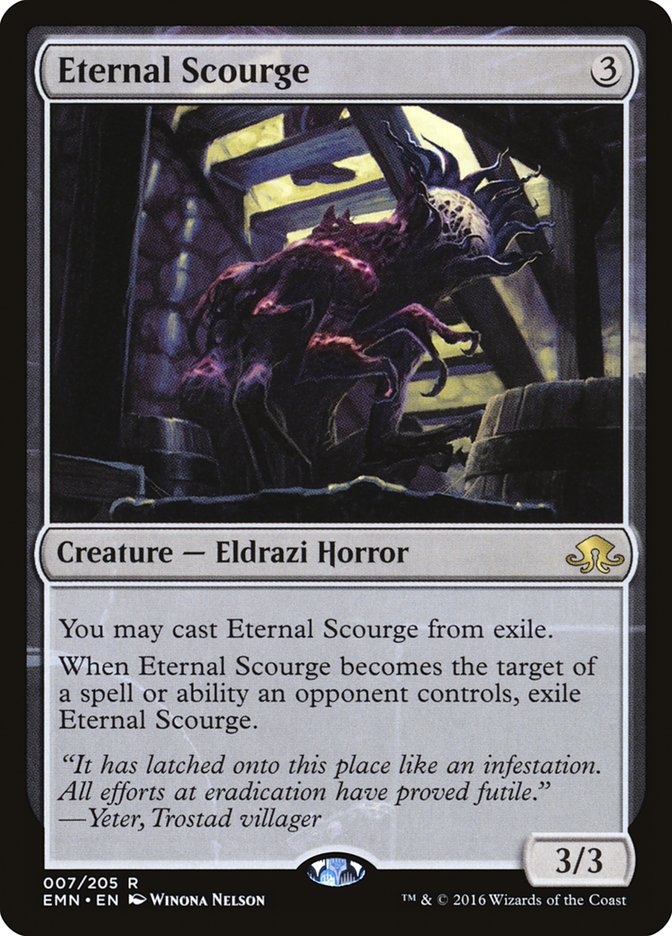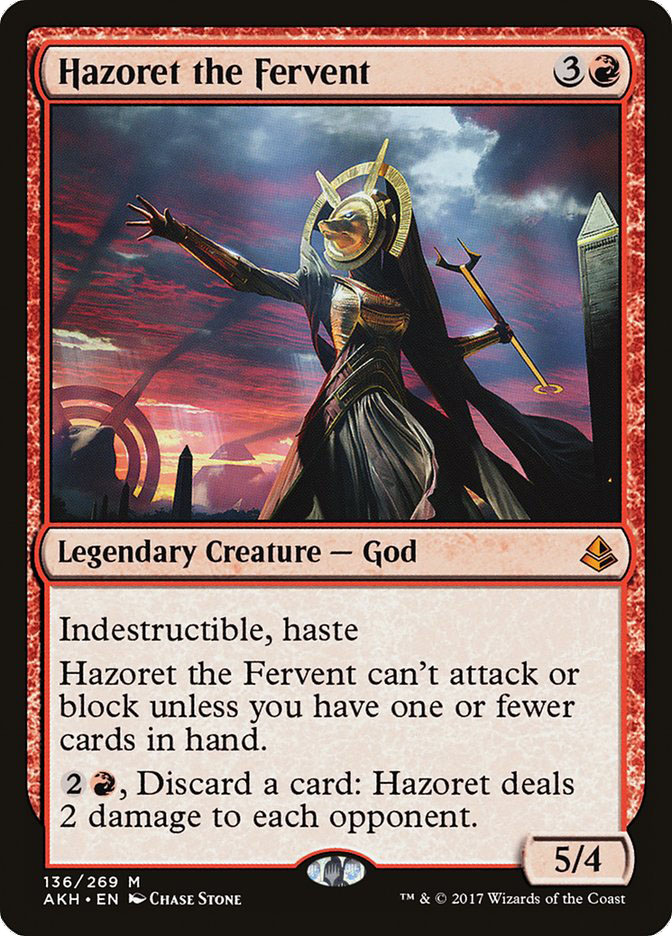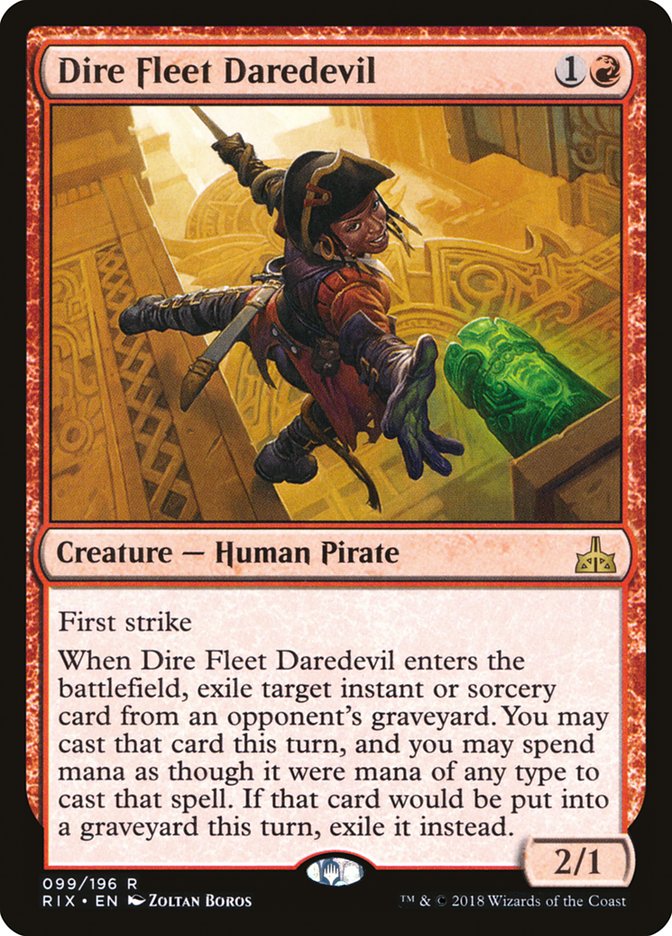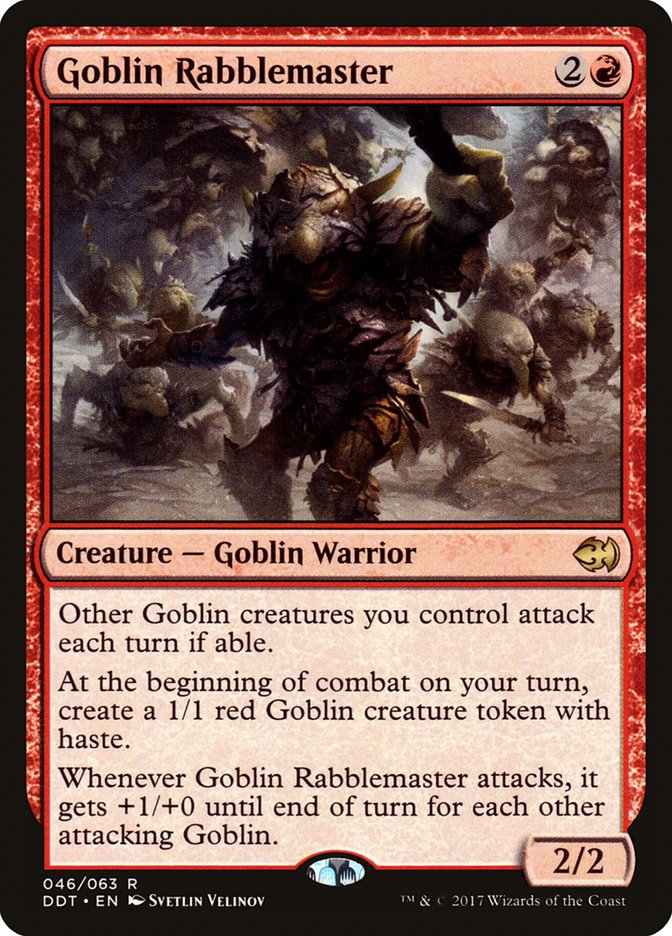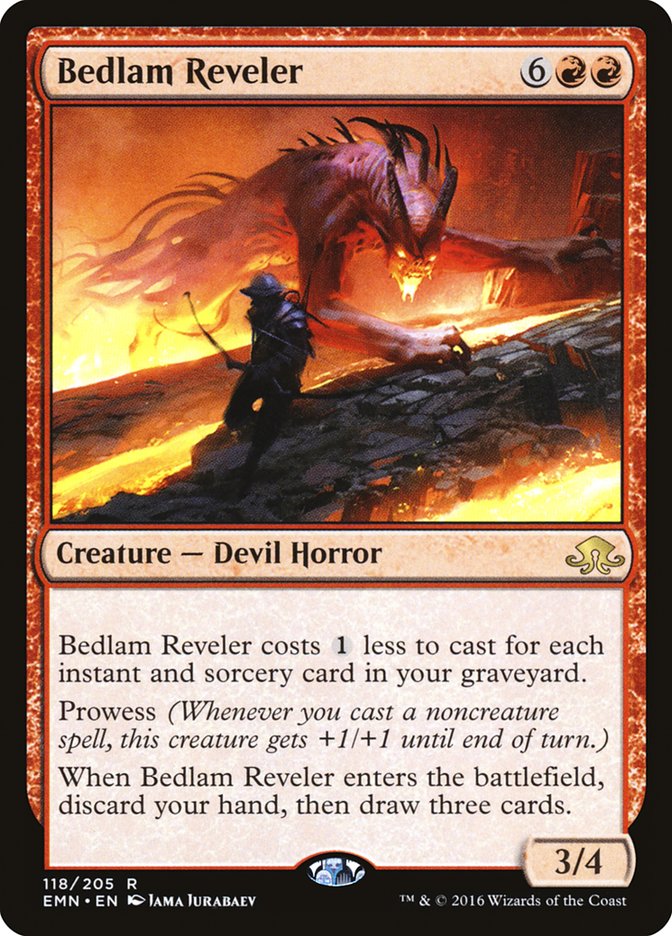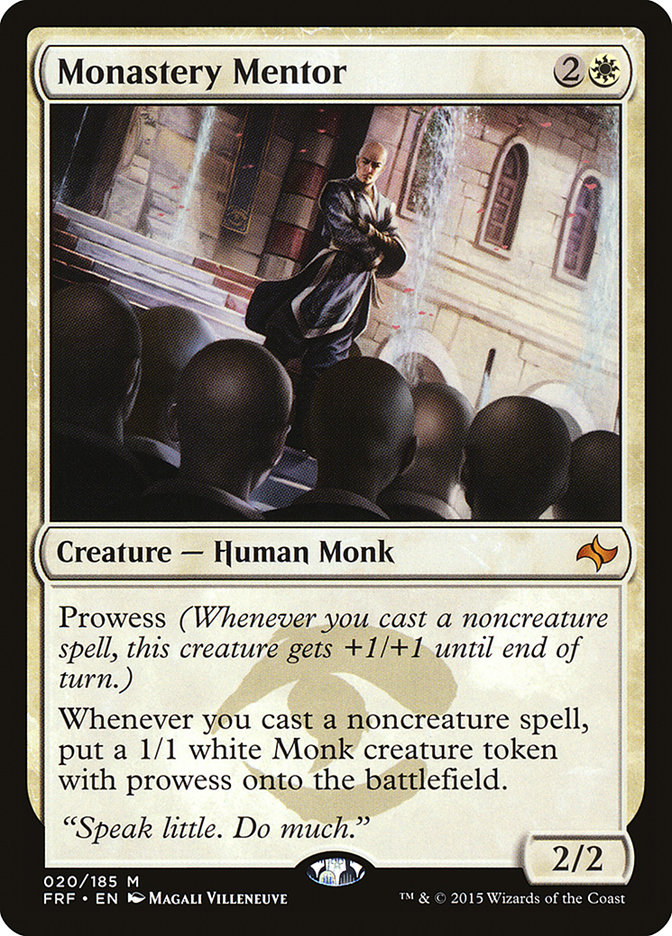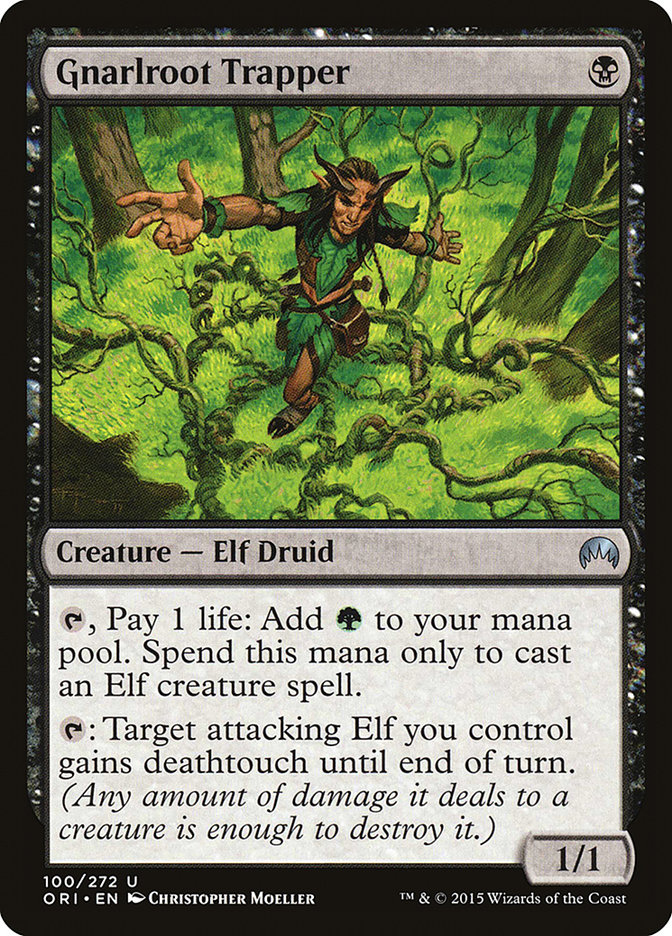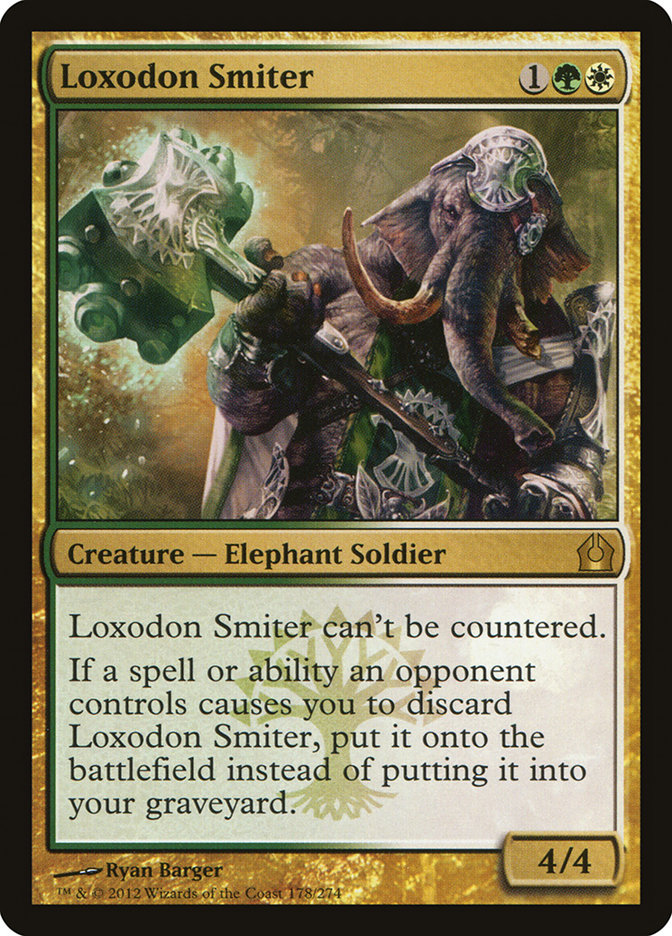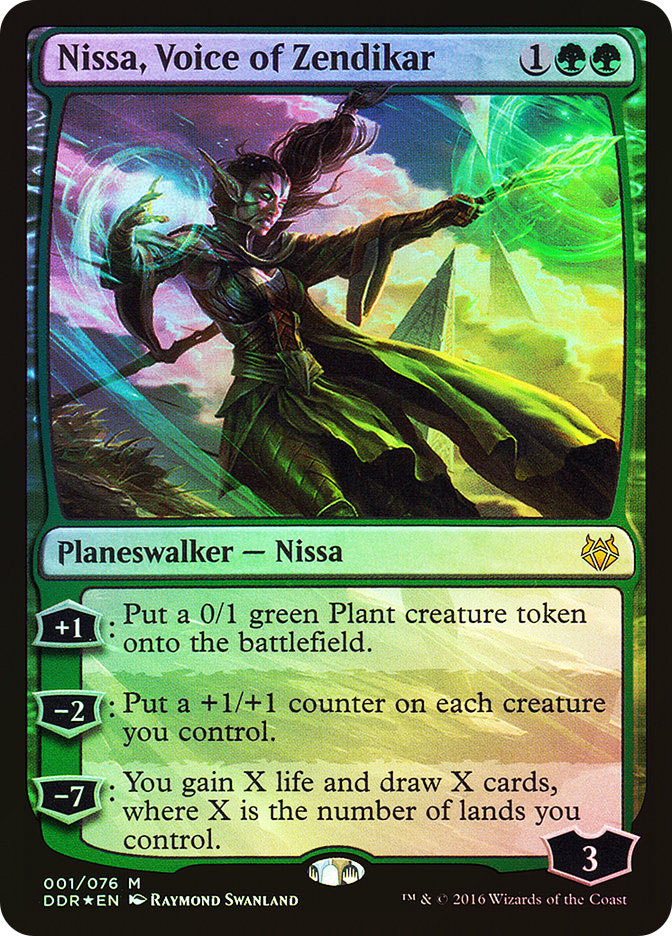The new Modern metagame is slowly forming, with the results of the first
large paper tournament, the about 400 person Modern Classic at #SCGWOR, coming in this
past weekend. The Top 16 was still as diverse as ever, with sixteen
different archetypes, showing that even with Jace, the Mind Sculptor and
Bloodbraid Elf in the format you can still play anything you want to and
find success any given weekend. Even with Modern continuing to be diverse,
it isn’t just the same old decks from before the unbannings that we are
seeing have success.
Jund has turned into the newest “Level 0” deck that the format is molding
around due to its consistency, disruption, and now added speed from
Bloodbraid Elf.
I wrote last week
about how Modern is a slightly faster format than it was previously, a
point that I’ll be reiterating at various times this week. Both new and old
decks alike have been adapting to the Jund-heavy metagame, and today I’m
going to be writing about the new technology that is having success so far
in this new Modern format. There’s not a better place to start with than
with the #SCGWOR Modern
Classic winning deck, Colorless Eldrazi:
Creatures (24)
- 4 Simian Spirit Guide
- 4 Eldrazi Mimic
- 4 Reality Smasher
- 4 Thought-Knot Seer
- 4 Matter Reshaper
- 4 Eternal Scourge
Lands (23)
Spells (13)

Colorless Eldrazi has been a very fringe archetype on Magic Online for
quite some time now, but this past weekend it had its breakout in a large
paper tournament in the hands of Jordan Boisvert. This is basically the
“Zoo” version of Eldrazi Tron, being much faster but lacking the power that
the abundance of mana from the Tron lands provides. With the new speed of
the format, Colorless Eldrazi can race other aggressive strategies while
still having plenty of hidden card advantage to allow it to grind out the
midrange decks.
Eternal Scourge is the biggest difference between this deck and Eldrazi
Tron and is the piece of technology I’d like to focus on. Aptly named,
Eternal Scourge is the Eldrazi that never truly dies as each time it is
targeted it gets put into exile, a zone where you are able to cast it again
from. Many Modern decks don’t have a way to get Eternal Scourge into the
graveyard besides in combat or with a sweeper, and even when it’s there,
Scavenger Grounds can exile it to be recast. Also Serum Powder, which
improves the consistency of finding Eldrazi Temple, gives the deck the
ability to mulligan into essentially a larger than seven card hand, as
every Eternal Scourge exiled with Serum Powder is castable as if it was in
your hand.
Honestly, I don’t see Colorless Eldrazi being a big player moving forward
in the Modern metagame. It has some glaring holes with struggling mightily
against the big mana decks as well as tribal strategies like Humans and
Elves, and moving forward I’d prefer to be on G/R Eldrazi or Eldrazi Tron.
That being said, Colorless Eldrazi has the best early turns out of any of
those decks, which allows it to beat anything with the right draws.
Creatures (10)
Lands (18)
Spells (32)

Next up is an incredibly impressive deck, Four-Color Pyromancer from Daniel
Schriever, which is an evolution of Mardu Pyromancer which splashes for
Traverse the Ulvenwald. Mardu Pyromancer was already in the market for
filling the graveyard in order to abuse Bedlam Reveler, and with the
addition of Traverse the Ulvenwald to the deck, it’s much easier to find
Bedlam Reveler.
As a one mana tutor, I’ve always thought it was just a matter of time
before Traverse the Ulvenwald became a Modern staple, and this is the best
shell I’ve ever seen for the card, including the Death’s Shadow builds.
Bedlam Reveler just allows this deck to out-grind everything, making this
deck a solid choice in the current Jund-heavy metagame. It also shares the
next piece of technology I wanted to touch on with this more traditional
Jund decklist.
Creatures (15)
Planeswalkers (5)
Lands (25)
Spells (15)

Even though it’s not the four-drop on everyone’s mind right now, I’m a big
fan of having access to a sideboard Hazoret the Fervent in Jund. First and
foremost, the role of Hazoret is for mirror matches, where the only clean
answer to it on the other side of the battlefield is Liliana of the Veil.
Besides that, it’s another way to greatly increase your clock against the
big mana and combo decks where you’re relying on discard in the early turns
and removal gets sideboarded out.
Finally, it’s a nice safety valve to the Blood Moon decks that are running
around as you can cast it and use its ability to slowly clear your hand of
uncastable spells to finish the game.
Creatures (6)
Planeswalkers (5)
Lands (24)
Spells (25)

Creatures (28)
- 1 Akroma, Angel of Fury
- 3 Flickerwisp
- 4 Leonin Arbiter
- 4 Blade Splicer
- 4 Thalia, Guardian of Thraben
- 3 Restoration Angel
- 2 Pia and Kiran Nalaar
- 4 Thraben Inspector
- 3 Dire Fleet Daredevil
Lands (22)
Spells (10)

Next up is Dire Fleet Daredevil from Magic’s newest set, Rivals of Ixalan. Not only have we seen it in the sideboard of
Humans decks, but now it’s starting to pop up in the main deck of multiple
strategies.
It’s really hard to play against a deck where Dire Fleet Daredevil won’t
have any target at all and with the format filled with decks utilizing
interaction spells, it makes Dire Fleet Daredevil a viable maindeck option.
Also, remember that Dire Fleet Daredevil exiles the card from the graveyard
to start with, even if you don’t have the mana to cast it right then, so
worst case scenario, it can get rid of an important Faithless Looting or
Lingering Souls.
Lars Dam’s Grixis Control list played two copies as basically Snapcaster
Mages five and six, and had the ability to use Jace, the Mind Sculptor to
shuffle them away if need be. That’s not the most exciting shell for our
new card though, as W/R Death and Taxes has been putting up good results on
Magic Online over the past couple of weeks. Both Flickerwisp and
Restoration Angel can flicker the Dire Fleet Daredevil for even more card
advantage in the matchups where it shines. With all of the most played
cards in the format being cheap instants and sorceries, such as Lightning
Bolt and Thoughtsieze, I expect Dire Fleet Daredevil will only see more and
more play moving forward.
Creatures (14)
Lands (19)
Spells (27)

For those of you that don’t care about interacting with the opponent as
much and would rather finish matches to have plenty of time between rounds
to get a snack, let’s go over to CodeProvider’s latest “Grishoalbrand”
list. CodeProvider has been putting up results on Magic Online for over a
year now, so if there is anyone who knows the deck well, it’s them. I love
their newest sideboard innovation of Goblin Rabblemaster.
I don’t know about you, but the first thing I do when sideboarding against
this deck is to take out all of my spot removal that I believed would be
blank cardboard, and that’s exactly the type of thinking Goblin
Rabblemaster will prey on. This archetype has always been an incredibly
good game-1 deck against the field but struggles to win sideboard games
when the opponent can tune their deck against yours. Goblin Rabblemaster
can “steal” a sideboard game when your opponent isn’t expecting it, which,
similar to Blood Moon, is the exact type of card you want in the sideboard
in this deck.
Creatures (12)
Lands (20)
Spells (28)

Creatures (13)
Lands (20)
Spells (27)

The power of Bedlam Reveler isn’t just for Mardu Pyromancer decks anymore,
as we’ve even seen it start to move into Burn now as well. Josh
Utter-Leyton brought a new take on Burn to the Magic Online Championship
that had three Bedlam Reveler in the maindeck along with Manamorphose to be
able to refuel when the first hand of burn spells wasn’t enough. This was
reminiscent of the days when Treasure Cruise was legal in the format, and
even Burn splashed for the powerful draw spell.
I think Josh Utter-Leyton was on the right track and that Burn can benefit
from utilizing Bedlam Reveler, but I’m not sold having it in the main deck
over Eidolon of the Great Revel is the way to go. Burn is another good
game-1 deck that struggles with sideboard games where opponents have more
interaction for the specific axis on which you’re trying to win. In this
light, sideboard games are where Bedlam Reveler can shine, and to that end
I like the adaptation Wite1 used, with Bedlam Reveler in the sideboard of
their Burn deck.
Creatures (10)
Planeswalkers (2)
Lands (20)
Spells (28)

Another week, another awesome h0lydiver list to talk about.
The power of Monastery Mentor is undeniable as it sees play as a finisher
in both Legacy and Vintage, but has never found a true home in Modern. I
don’t expect that to be a true sentence for too long, however, as it’s a
card that gains a ton from the unbanning of Jace, the Mind Sculptor as the
two cards work incredibly well together in the other formats. Exactly how
to build the Modern version of a Monastery Mentor and Jace, the Mind
Sculptor deck will take time, but the potential is there to be the backbone
of a tier one shell. I haven’t been the biggest supporter of Disrupting
Shoal in Modern, but I like it in this shell where h0lydiver is using it to
protect threats from the first removal spell, which should buy enough time
to turn the corner and have the incidental advantages they provide spiral
out of control. It’s not as straightforward as making a Jund deck, but with
enough work there could be an incredible Monastery Mentor and Jace the Mind
Sculptor deck out there for those looking for a new project.
Creatures (22)
- 3 Birds of Paradise
- 4 Tarmogoyf
- 3 Kitchen Finks
- 4 Noble Hierarch
- 4 Bloodbraid Elf
- 1 Inferno Titan
- 3 Tireless Tracker
Planeswalkers (3)
Lands (22)
Spells (13)
Sideboard

Creatures (8)
Planeswalkers (1)
Lands (20)
Spells (31)

Nahiri, the Harbinger burst onto the Modern scene shortly after being
legal, with Jeskai Control and W/R Prison taking advantage of the powerful
planeswalker to cheat Emrakul, the Aeons Torn onto the battlefield.
Recently though, she’s almost been forgotten, with only some Jeskai Control
lists still playing her for the flexibility she provides. We’re entering a
new age though where Nahiri is looking to make a comeback, and I’m all
aboard.
Let’s start with Naya Land Destruction, where Nahiri solves a ton of
problems the traditional G/R version of the deck had before. G/R Land
Destruction is built to slow the opponent down by exploiting their
manabase, but in order to do that the deck is filled with cards that are
terrible late game draws, which Nahiri can cycle though to find more
threats. Also, large creatures with more than three toughness have
traditionally been a problem, and Nahiri can exile them after the first
attack. Finally, using Nahiri’s ultimate ability to fetch for a hasty
Inferno Titan to receive both the enters-the-battlefield and attack
triggers in the same turn is devastating.
This isn’t the only home I’m excited for with Nahiri though, as Mardu
Pyromancer is another perfect shell for it. Between the discard spells in
the deck, along with Young Pyromancer and Lingering Souls tokens,
protecting Nahiri isn’t much to ask for, even without considering starting
at six loyalty after one activation. With this protection Nahiri will be
able to ultimate a good percentage of the times you play her, and the
reward is incredible with Bedlam Reveler not only entering the battlefield
once to refill your hand, but also then returning to your hand at the end
step in order for you to cast it again the following turn. I’m a huge fan
of Nahiri in both of these strategies, and am looking forward to where else
she can shine.
Creatures (36)
- 4 Llanowar Elves
- 1 Elvish Champion
- 4 Heritage Druid
- 4 Nettle Sentinel
- 4 Bloodbraid Elf
- 4 Elvish Archdruid
- 2 Ezuri, Renegade Leader
- 4 Elvish Mystic
- 4 Dwynen's Elite
- 1 Gnarlroot Trapper
- 4 Shaman of the Pack
Lands (19)
Spells (5)

Elves is an under-the-radar deck for Bloodbraid Elf to join, but it
shouldn’t be forgotten. This version shifts away from combo cards like
Devoted Druid and Vizier of Remedies and instead focuses on being
aggressive with Shaman of the Pack and winning through combat.
To that end Gnarlroot Trapper is wonderful one-drop, as it not only helps
accelerate by casting your creatures but also makes blocking almost
impossible by being able to give an attacking creature deathtouch. Usually
when playing a strategy like Elves, where the goal is to go wide and attack
with many creatures, you are forced to “chump-attack” where whichever
creature is blocked will die without trading. With Gnarlroot Trapper, all
of your creatures represent a trade when an opponent is trying to decide if
they want to block with a Tarmogoyf, for example, which is crucial when
trying to win over a couple attack steps. Although there was only one
Gnarlroot Trapper in this list, it’s a card that I could see end up being a
three or four of and that helps put this Jund version of Elves on the map.
Creatures (31)
- 4 Wild Nacatl
- 4 Noble Hierarch
- 4 Knight of the Reliquary
- 4 Bloodbraid Elf
- 2 Scavenging Ooze
- 4 Loxodon Smiter
- 4 Voice of Resurgence
- 2 Selfless Spirit
- 3 Renegade Rallier
Lands (23)
Spells (6)

Creatures (19)
Planeswalkers (4)
Lands (22)
Spells (15)

Lightning Bolt has quickly become the number one card in Modern and is
seemingly everywhere, so having creatures that match up well against
Lightning Bolt is vital. Pair that with Jund making Liliana of the Veil
widely played and the stock of Loxodon Smiter is through the roof right
now.
Even though there is enormous competition at the three mana slot for green
and white creatures, Loxodon Smiter was a four-of in these recent Naya and
Abzan lists and for good reason. Besides surviving a Lightning Bolt or
entering the battlefield for free when forced to discard by an opposing
Liliana of the Veil, it also brickwalls a Bloodbraid Elf or trades with a
Hollow One or Thought-Knot Seer. This is all without mentioning that the
control decks can’t simply counter the Elephant Soldier. It’s time to go
back to the old trade binder and find those Loxodon Smiters, because for
the first time since Fatal Push was printed, Lightning Bolt is the defining
removal spell of the format again, and four toughness is exactly where you
want your creatures to be.
Creatures (25)
- 4 Birds of Paradise
- 4 Tarmogoyf
- 2 Kitchen Finks
- 4 Noble Hierarch
- 4 Bloodbraid Elf
- 3 Scavenging Ooze
- 1 Courser of Kruphix
- 2 Tireless Tracker
- 1 Rhonas the Indomitable
Planeswalkers (5)
Lands (22)
Spells (8)

To finish out today we have the deck I’ve been working on myself and what I
played at the #SCGWOR
Modern Classic this past weekend. It’s similar in nature to the G/R Land
Destruction lists which have become popular with the unbanning of
Bloodbraid Elf, except instead of playing the land destruction spells, I’m
playing versatile midrange threats that are good hits off of Bloodbraid
Elf, most notably Nissa, Voice of Zendikar.
The downside to playing plenty of mana creatures in a deck is that they
don’t scale well into the late game, but a card like Nissa, Voice of
Zendikar mitigates that downside as it can grow your creatures into
respectable battlefield threats. The minus ability also can reset your
Kitchen Finks, grow your Tarmogoyfs to outclass opposing Tarmogoyfs, or
make a creature large enough for Rhonas the Indomitable to be able to
attack and block. It also works well defensively when need be by creating
chump blockers, and threatens to ultimate and draw plenty of cards in this
way at the same speed as a suspended Ancestral Vision. I’ve been incredibly
impressed with Nissa, Voice of Zendikar in this deck, and it’s a card I’ll
have in the back of my mind when building Bloodbraid Elf decks or even
Jace, the Mind Sculptor decks as a way to provide protection for Jace in
the future.
So there we have it, some of the newest technology Modern decks are using
for success in the new format. Did I miss anything you’ve been using and
impressed with? If so, let me know! I can’t wait to play this new format on
the SCG Tour for the first time this weekend back in my home state of Texas
and honestly, I’m expecting it to be the largest Open of all time! I’m not
the only one, as the
capacity has been increased to 1,200 people
, but even still, make sure you register early as it may cap!
At least I know the weather will be a whole lot better than last weekend!


